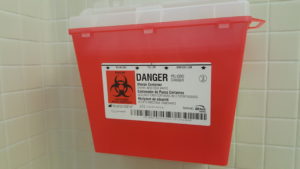Most of the attendees at my training events – check my Schedule of Events to see when I’ll be in your area – come from the manufacturing industry. There are many other commercial activities that are subject to the US DOT regulations governing the transportation of hazardous materials and the US EPA regulations governing the generation, handling, and disposal of hazardous waste; one of these is hospitals (SIC’s 8062 & 8069). As a matter of fact, a hospital administrator recently pled guilty to criminal charges of willfully or knowingly disposing of hazardous waste (STERIS 20 in this case) in an improper manner (click here for the Agency press release).
In the eyes of the US EPA, a hospital is no different than any other industrial facility subject to its hazardous waste regulations found in 40 CFR 260-265. Before you can comply with the regulations however, and avoid the violations listed below, you must be aware of the potential violations.
Below is a list of the 15 Most common Hazardous Waste Violations and Problems Found at Hospitals according to US EPA Region 2. I included my own comments where I think they may be helpful. You can see the original listhere.
| 1. Improper or lack of hazardous waste labeling. | To label a container is so easy, and so easily overlooked. |
| 2. No or infrequent weekly inspections of hazardous waste storage areas. | For both Large Quantity Generators of hazardous waste andSmall Quantity Generators, “weekly” means “every 7 days”. |
| 3. Open containers of hazardous waste. | Containers of hazardous waste must be kept closed at all times except when adding or removing waste. See here for more information. |
| 4. Improper disposal of chemotherapy drugs. | Like any waste, they are subject to the hazardous waste determination process. See #5. |
| 5. Failure to perform or improper hazardous waste determinations. | This is a critical fiirst step in the process of determining what regulations apply to you as a generator of hazardous waste. |
| 6. No or inadequate hazardous waste manifests. | The Uniform Hazardous Waste Manifest must be used for all shipments of hazardous waste, unless you are a Conditionally Exempt Small Quantity Generator of hazardous waste. |
| 7. Throwing hazardous waste down the drain. | A tempting, but illegal option. See the news release referred to above. |
| 8. Improper management of mercury-containing wastes, including but not limited to: fluroescent light bulbs, mercury vapor lights, thermometers, sphygmomanometer, gastric tubes, thermostats, etc. | All of these items could be handeld as universal waste at a greatly reduced regulatory burden. |
| 9. Improper management of expired pharmaceuticals, paints, etc. | Like any waste, they are subject to the hazardous waste determination process. See #5. |
| 10. Lack of a contingency plan. | Large Quantity Generators of hazardous waste must have a contingency plan. |
| 11. Lack of or inadequate training of employees in hazardous waste management. | This is where it all starts! Not only is a lack of training a violation in itself, but without training you miss an opportunity to teach your employees about the regulations and proper waste handling. Note that “inadequate training” is also a violation. |
| 12. Failure to ensure that hazardous waste meets the Land Disposal Restrictions. | Usually, your hazardous waste disposal vendor will help you with the completion of the LDR. However, it is your responsibility as the generator to ensure compliance. |
| 13. Failure to upgrade/close underground storage tanks (UST’s). | |
| 14. Malfunctioning leak detection systems. | |
| 15. Improper consolidation of wastes from nearby facilities. | Use caution when consolidating waste from another facility with your own. |
All of the above violations, except for numbers 13 & 14 are covered extensively at my training events. For as low as $475 you can attend an entire day of training that meets not only the US EPA hazardous waste regulations, but the US Department of Transportation regulations for the transportation of hazardous materials (HazMat). Don’t forget that the off-site transportation of hazardous waste is regulated by the US DOT as is the receipt of the hazardous materials as product.
Please don’t hesitate to contact me with questions about my training services and how they might apply to your operations. I can tailor the training to your needs, including conducting on-site training for all of you applicable employees in one day.


